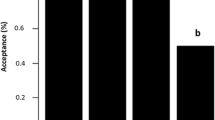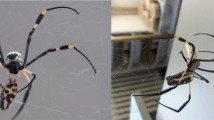Abstract
Assassin bugs from the genus Stenolemus (Heteroptera, Reduviidae) are predators of web-building spiders. However, despite their fascinating lifestyle, little is known about how these insects hunt and catch their dangerous prey. Here we characterise in detail the behaviour adopted by Stenolemus bituberus (Stål) during encounters with web-building spiders, this being an important step toward understanding this species’ predatory strategy. These bugs employed two distinct predatory tactics, “stalking” and “luring”. When stalking their prey, bugs slowly approached the prey spider until within striking range, severing and stretching threads of silk that were in the way. When luring their prey, bugs attracted the resident spider by plucking and stretching the silk with their legs, generating vibrations in the web. Spiders approached the luring bug and were attacked when within range. The luring tactic of S. bituberus appears to exploit the tendency of spiders to approach the source of vibrations in the web, such as might be generated by struggling prey.





Similar content being viewed by others
References
Anton S, Gnatzy W (1998) Prey specificity and the importance of close-range chemical cues in prey recognition in the digger wasp, Liris niger. J Insect Behav 11:671–690
Blackledge TA, Pickett KM (2000) Predatory interactions between mud-dauber wasps (Hymenoptera, Sphecidae) and Argiope (Araneae, Araneidiae) in captivity. J Arachnol 28:211–216
Brumm H, Vozz K, Köllmer I (2004) Acoustic communication in noise: regulation of call characteristics in a New World monkey. J Exp Biol 207:443–448
Cerveira AM, Jackson RR, Guseinov EF (2003) Stalking decisions of web-invading araneophagic jumping spiders from Australia, Azerbaijan, Israel, Kenya, Portugal, and Sri Lanka: the opportunistic smokescreen tactics of Brettus, Cocalus, Cyrba, and Portia. NZ J Zool (Lond) 30:21–30
Coville RE (1976) Predatory behavior of the spider wasp, Chalybion californicum (Hymenoptera: Sphecidae). Pan Pacific Entomol 52:229–233
Eberhard WG (1977) Aggressive chemical mimicry by a bolas spider. Science 198:1173–1175
Harland DP, Jackson RR (2000) Cues by which Portia fimbriata, an araneophagic jumping spider, distinguishes jumping-spider prey from other prey. J Exp Biol 203:3485–3494
Harland DP, Jackson RR (2006) A knife in the back: use of prey-specific attack tactics by araneophagic jumping spiders (Araneae: Salticidae). J Zool (Lond) 269:285–290
Haynes KF, Yeargan KV, Gemeno C (2001) Detection of prey by a spider that aggressively mimics pheromone blends. J Insect Behav 14:535–544
Hickman VV (1969) The biology of two emesine bugs (Hemiptera: Reduviidae) occurring on the nests or webs of spiders. J Entomol Soc Aust (NSW) 6:3–18
Hodge M (1984) Anti-predator behavior of Achaearanea tepidariorum (Theridiidae) towards Stenolemus lanipes (Reduviidae): preliminary observations. J Arachnol 12:369–370
Jackson RR (1989) The biology of Cobanus mandibularis, a jumping spider (Araneae: Salticidae) from Costa Rica: intraspecific interactions, predatory behaviour, and silk utilization. NZ J Zool 16:282–392
Jackson RR (1990) Predatory and nesting behaviour of Cocalus gibbosus, a spartaeine jumping spider (Araneae: Salticidae) from Queensland. NZ J Zool 17:483–490
Jackson RR, Brassington RJ (1987) The biology of Pholcus phalangioides (Araneae, Pholcidae): predatory versatility, araneophagy and aggressive mimicry. J Zool (Lond) 211:227–238
Jackson RR, Hallas SEA (1986) Comparative biology of Portia africana, P. albimana, P. fimbriata, P. labiata, and P. shultzi, araneophagic, web-building jumping spiders (Araneae: Salticidae): utilisation of webs, predatory versatility, and intraspecific interactions. NZ J Zool 13:423–489
Jackson RR, Pollard SD (1997) Jumping spider mating strategies: sex among cannibals in and out of webs. In: Choe JC, Crespi BJ (eds) The evolution of mating systems in insects and arachnids. Cambridge University Press, Cambridge, pp 340–351
Jackson RR, Whitehouse MEA (1986) The biology of New Zealand and Queensland pirate spiders (Araneae, Mimetidae): aggressive mimicry, araneophagy and prey specialization. J Zool (Lond) 210:279–303
Jackson RR, Wilcox RS (1993) Spider flexibly chooses aggressive mimicry signals for different prey by trial and error. Behaviour 127:21–36
Jackson RR, Willey MB (1994) The comparative study of the predatory behaviour of Myrmarachne, ant-like jumping spiders (Araneae, Salticidae). Zool J Linn Soc 110:77–102
Jackson RR, Brassington RJ, Rowe RJ (1990) Anti-predator defences of Pholcus phalangioides (Araneae, Pholcidae), a web-building and web-invading spider. J Zool (Lond) 220:543–552
Jackson RR, Pollard SD, Cerveira AM (2002) Opportunistic use of cognitive smokescreens by araneophagic jumping spiders. Anim Cogn 5:147–157
Laing DJ (1988) The prey and predation behaviour of the wasp Pison morosum (Hymenoptera: Sphecidae). NZ Entomol 11:37–42
Land MF (1969) Structure of the retinae of the principal eyes of jumping spiders (Salticidae: Dendryphantinae) in relation to visual optics. J Exp Biol 51:443–470
Lengagne T, Aubin T, Lauga J, Jouventin P (1999) How do king penguins (Aptenodytes patagonicus) apply the mathematical theory of information to communicate in windy conditions? Proc R Soc Lond B 266:1623–1628
Li D, Jackson RR, Barrion AT (1999) Parental and predatory behaviour of Scytodes sp., an araneophagic spitting spider (Araneae: Scytodidae) from the Philippines. J Zool (Lond) 247:193–310
Lloyd JE (1975) Aggressive mimicry in Photuris fireflies: signal repertoires by femmes fatales. Science 187:452–453
Ord TJ, Peters RA, Clucas B, Stamps JA (2007) Lizards speed up visual displays in noisy motion habitats. Proc R Soc Lond B 274:1057–1062
Peters RA, Hemmi JM, Zeil J (2007) Signaling against the wind: modifying motion-signal structure in response to increased noise. Curr Biol 17:1231–1234
Pietsch TW, Grobecker DB (1978) The compleat angler: aggressive mimicry in an antennariid anglerfish. Science 201:369–370
Tarsitano M, Jackson RR, Kirchner WH (2000) Signals and signal choices made by the araneophagic jumping spider Portia fimbriata while hunting the orb-weaving web spiders Zygiella x-notata and Zosis geniculatus. Ethology 106:595–615
Wickler W (1968) Mimicry in plants and animals. Weidenfeld and Nicolson, London
Wignall AE, Taylor PW (2008) Biology and life history of the araneophagic assassin bug Stenolemus bituberus including a morphometric analysis of the instars (Heteroptera, Reduviidae). J Nat Hist 42:59–76
Wignall AE, Taylor PW (2009) Alternative predatory tactics of an araneophagic assassin bug (Stenolemus bituberus). Acta Ethol 12:23–27
Wilcox SR, Jackson RR, Gentile K (1996) Spiderweb smokescreens: spider trickster uses background noise to mask stalking movements. Anim Behav 51:313–326
Wise DH (1993) Spiders in ecological webs. Cambridge University Press, New York
Wygodzinsky PW (1966) A monograph of the Emesinae (Reduviidae, Hemiptera). Bull Am Mus Nat Hist 133:1–614
Acknowledgments
We thank Chris Evans and Robert Jackson for helpful comments throughout the study. We also thank Marie Herberstein and Aaron Harmer for comments on the manuscript. This study was supported by a grant from the Australian Research Council. AEW was supported by a RAACE scholarship from Macquarie University.
Author information
Authors and Affiliations
Corresponding author
Electronic supplementary material
Below is the link to the electronic supplementary material.
Supplementary material 1 (MOV 5529 kb)
Supplementary material 2 (MOV 5704 kb)
Supplementary material 3 (MOV 3550 kb)
About this article
Cite this article
Wignall, A.E., Taylor, P.W. Predatory behaviour of an araneophagic assassin bug. J Ethol 28, 437–445 (2010). https://doi.org/10.1007/s10164-009-0202-8
Received:
Accepted:
Published:
Issue Date:
DOI: https://doi.org/10.1007/s10164-009-0202-8




